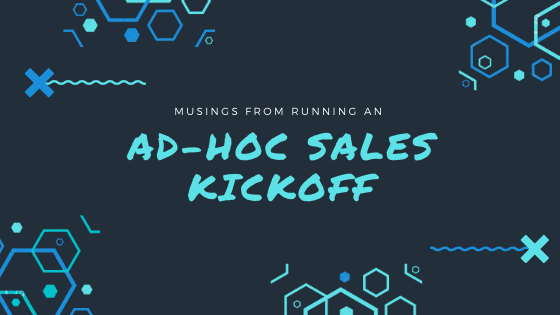Generally, when you execute a sales kick-off, you have a lot of planning. For my last two kick-offs,I started the process over four months before the event. But with Covid-19 the situation was rapidly changing and we found our customer-facing employees with a lot of available downtime. My sales SVP and other senior leaders wanted to use this opportunity to deliver training to upskill customer-facing employees.
It wasn’t strictly a kick-off as we were in the middle of our Q4. We didn’t have the usual kick-off preamble, as we couldn’t review results or give awards. This made me happy, as while I like recognizing success, I find the executive keynotes not particularly useful in enabling sales. Yes, they need to hear from execs, but I think a short speech with Q&A is far more helpful than the traditional keynote.
We delivered a kick-off level of material. We delivered more content over five weeks than we did at the last event we ran last summer. Our estimate is that reps received roughly 50 hours of training over those 5 weeks. And we did so with only one week of planning! Not ideal, but effective use of reps, customer success, and service downtime.
I had no idea how we were going to do it when I met with my sales SVP. He offered his vision for the event—enabling 100+ customer-facing employees on a variety of topics with almost no advanced planning. Oh, and all done virtually. We managed to complete it, and it reinforced some of my long-held precepts for enablement.
- Segment your audience – It was effortless to set up a virtual session, and then invite everyone to it. We set up the intention not to do this as we established the program. Still, the temptation was there to expand the sessions to cover a larger audience, as many groups had downtime. The reality is that the sessions were a lot better with a focused audience.
- Make it fun – Well this is something I try to do with any training, virtual or in-person. Enablement is viewed as a chore by most sales professionals. Anything you can do to amp up the fun, especially on a web conference makes it worth doing. Some things we did were wearing costumes, asking our participants to wear them, and using a game show format.
- Use every aspect of your web conferencing tools – Make sure to know what your tools can do backward and forwards, and then use it. We did experience some tool outages, but we leveraged every feature we could to make it more engaging. We had used polls and breakout rooms in the past, never to this level.
- Try to make it interactive – Again, this is something you should strive to do with any enablement. But in short, it’s easy to default to lecture mode. Instead, we made sure every session had some element of interactivity, whether this was a breakout, an activity, or a game. This encouraged people not just to attend but to engage.
- It takes a village – For any kick-off, it’s teamwork that gets it done. It’s easy to think with virtual; you need fewer individuals involved. This simply is not the case though, managing and delivering virtual content requires just as much planning and execution as in-person events.
Overall the experience was a challenge but also fun in a weird sort of chaotic way. I love doing virtual enablement, as I think the retention of materials is higher than in-person. This allowed me to explore different ways to deliver content.
I do think we upskilled our customer-facing employees in the process, but I would hope next time I would get more time to do it!

